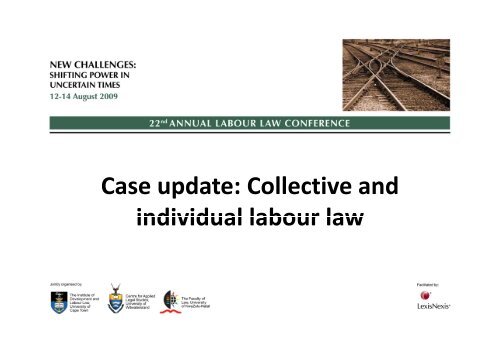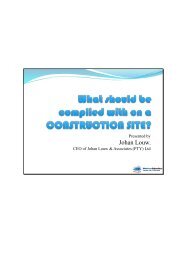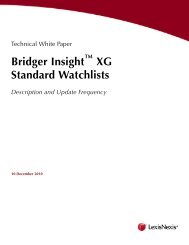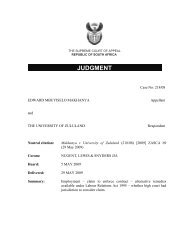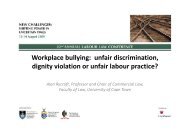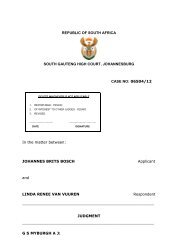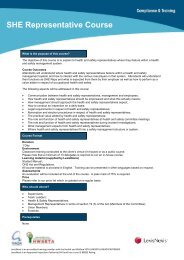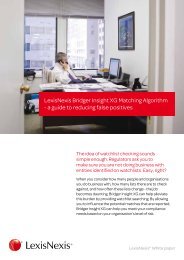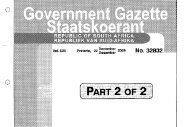3.3_Case update by Benita Whitcher.pdf
3.3_Case update by Benita Whitcher.pdf
3.3_Case update by Benita Whitcher.pdf
You also want an ePaper? Increase the reach of your titles
YUMPU automatically turns print PDFs into web optimized ePapers that Google loves.
<strong>Case</strong> <strong>update</strong>: d Collective ll and d<br />
individual labour law
Illegal ll l contracts and d unfair f i di dismissal i l actions i<br />
Discovery i Health lhLtdd v CCMA &others h [ [2008] ] 7 BLLR ( (LC) )<br />
– Foreign nationals working without work permits are EEs as defined <strong>by</strong> the<br />
LRA<br />
– They may bring actions for unfair dismissals under the LRA.<br />
– Immigration g Act prohibits p employing p y g foreigners g without a work permit. p Onlyy<br />
consequence of doing so is that the ER is guilty of an offence.<br />
– To hold otherwise would frustrate the right of EEs to fair labour practices practices.
However:<br />
“Kylie” v CCMA &others[2008] 9 BLLR 870 (LC)<br />
– Sex workers EEs as defined <strong>by</strong> LRA, but statutory right not to be unfairly dismissed<br />
does not apply to them them.<br />
– Because of WHY their employment contracts are illegal.<br />
– To reinstate unfairly dismissed sex workers and afford them rights under the LRA<br />
would:<br />
• draw da arbitrators/courts abtatos/coutsinto to regulating egu at g an a illegalindustry;<br />
ega dust y;<br />
• encourage prostitution which is illegal.<br />
– Exclusion of sex workers from LRA not unconstitutional because CC in SvJordaan&<br />
others 2002 (6) SA 642 (CC) ruled that the prohibition of prostitution does not infringe<br />
sex workers’ rights to privacy and dignity
Unlawful entrapment<br />
NUMSA obo b Kholoanyane h l & others h v Wispeco i ( (Pty) ) Ltdd<br />
[2009] 2 BALR (MEIBC]<br />
– Dismissed EEs unlawfully entrapped and as a result their dismissals for theft<br />
were unfair.<br />
– However, further relief not appropriate because guilty of theft and theft is<br />
theft in whatever circumstances.
Constructive dismissal<br />
Murray v Minister of Defence [2008] 6 BLR 513 (SCA)<br />
– Naval officer [excluded from LRA] sued in HC for constructive dismissal.<br />
– SCA did 2 important things:<br />
• developed the common law to incorporate constructive dismissal;<br />
• incorporated concept of ‘employer culpability’ or ‘blameworthiness’ in<br />
test for constructive dismissal.<br />
– Held re (a): EEs may rely in civil claims on CD because EEs’ rights under the<br />
common law now virtually indistinguishable from their rights under labour<br />
llegislation. i l ti
Held, for CD, the EE must prove that:<br />
– s/he has terminated the employment contract;<br />
– th the conduct d t of f th the ER rendered d d the th continued ti d employment l t relationship l ti hi intolerable;<br />
i t l bl<br />
– the intolerability was of the ER’s making;<br />
– s/he resigned as a result of the intolerable behavior of the employer;<br />
– the resignation or termination of employment was a matter of last resort;<br />
– s/he has not resigned voluntarily;<br />
– s/he did not delay ytoo long gin terminating gthe contract in response p to the ER’s<br />
conduct.<br />
Added:- EE must prove ER is culpably responsible for the intolerable condition.
Culpability inquiry [response of ER to the situation central]:<br />
– whether ER to blame for the untenable situation the EE finds himself in;<br />
– if not solely to blame, whether its response to the situation was reasonable;<br />
– whether EE gave ER a chance to, and whether ER took reasonable steps, to rectify the situation.<br />
Assessing the EE’s complaints:<br />
– Examine cumulative effect of various incidents<br />
– Do not fragment g EE’s complaints p & consider them one <strong>by</strong> yone<br />
in isolation<br />
MEC for Department of Health, EC v Odendaal & others (P504/07)<br />
– ER stopped salary of EE who refused to accept new terms and conditions of employment. employment EE<br />
resigned<br />
– Held: No CD because EE had repudiated the contract and thus ER had no obligation to pay.
Automatically unfair constructive dismissal<br />
Marsland l d v New Way Motor &Diesel i l Engineering i i [ [2008] ] 11<br />
BLLR 1078 (LC)<br />
– M constructively dismissed in a manner that was automatically<br />
unfair.<br />
– Why: Main reason for the intolerable treatment of M <strong>by</strong> his ER was<br />
his mental condition.
Deemed dismissals – s 17(5) of the Public<br />
Service Act 1994 and s 14 of f the<br />
Employment of Educators Act 1998<br />
– Discharge of EEs under these provisions cannot be reviewed because <strong>by</strong> operation of<br />
law & does not require a decision <strong>by</strong> any official [Phenithi v Minister of Education &<br />
others [2006] 9 BLLR 821 (SCA)]<br />
Ndiki v DDepartment t t off AAgriculture i lt [2008] 6 BALR 505 (GPSSBC)<br />
– Doesn’t mean that such terminations do not constitute dismissals under LRA.<br />
– EEs deemed dismissed under these provisions may still pursue disputes under the LRA.<br />
– Dismissal of Nkidi procedurally p y unfair under LRA because ER had not informed him of<br />
his right under section 17(5) to apply for reinstatement.<br />
– Based on Ndiki, an ER’s failure to consider or properly consider representations from<br />
the discharged g EE re reinstatement mayy be challenged g under the LRA dismissal<br />
provisions.
Reviewing disciplinary decisions<br />
What may an ER do if dissatisfied with decision of a disciplinary hearing?<br />
(1) BMW (SA) (Pty) Ltd v Van der Walt [2000] 2 BLLR 121 (LAC):<br />
– Normally unfair and an infringement of the principle against double jeopardy for an ER<br />
to try an employee twice for the same offence.<br />
– However, in labour law fairness is the test and in “exceptional circumstances” it may<br />
be fair to permit an ER to hold a 2nd inquiry; unless 2nd inquiry “ultra vires a binding<br />
disciplinary code.<br />
(2) PSA of SA obo Venter v Laka NO & others [2006] 1 BLLR 20 (LC):<br />
– State ERs acquire the right from PSA to interfere with a sanction and substitute its own<br />
ddecision i i ffor th thatt off th the PO if th the ruling li was a recommendation d ti or if th the sanction ti was<br />
grossly unreasonable.
(3) MEC for Finance Finance, KwaZulu KwaZulu-Natal Natal & another v Dorkin NO & another [2008] 6 BLLR<br />
540 (LAC) held:<br />
– State ERs mayy take the decision on review because the PO’s decision constitutes<br />
administrative action.<br />
– In casu, the PO had not made a recommendation, but a ruling that was binding on the<br />
ER, so the ER could not substitute its own decision for that of the PO, but had to<br />
review it.<br />
– Found: given the seriousness of the offence, the PO’s decision to impose only a FWW<br />
was so aberrant that he must have failed to apply his mind to the matter.<br />
– Warning replaced with an order that the appropriate sanction was dismissal.
Interdicting disciplinary proceedings<br />
and suspensions<br />
SAMWU obo Abrahams & others v City of Cape Town [2008] 7 BLLR 700 (LC)<br />
– LC may intervene & interdict internal disciplinary proceedings in “exceptional<br />
circumstances”.<br />
– Exceptional circumstances in casu were: a large number of EEs were facing serious<br />
allegations ll ti off misconduct i d t th thatt could ld result lt iin di dismissal i l andd th the di disciplinary i li procedure d<br />
the ER intended to use was in violation of a CA.<br />
However:<br />
Booysen v SAPS & another [2008] 10 BLLR 928 (LC)<br />
– LC did not have jurisdiction to intervene in, review or interdict internal disciplinary<br />
proceedings.<br />
– LRA designed to allow EEs to challenge the fairness of dismissals at CCMA/BCs; not to<br />
obtain relief directly from the LC.<br />
– s 191 & 193 [LRA] [ ] -onlyy the CCMA/BCs / have jurisdiction j to determine the procedural p<br />
and substantive fairness of dismissals for misconduct.<br />
– LC does not have a ‘roving power to correct any injustice outside of the specific areas<br />
in which it was given jurisdiction’.
– Judicial oversight of disciplinary proceedings while in progress is costly costly, timeconsuming<br />
and disruptive and may also be premature as the EE may not be<br />
dismissed.<br />
– Once the disciplinary inquiry is completed, the procedural fairness of the<br />
inquiry as a whole can be determined, which may show that the purported<br />
procedural defect complained of did not render the inquiry, on the whole,<br />
unfair. f i<br />
Dladla v Council of Mbombela Local Muncipality [2008] 8 BLLR 751 (LC)<br />
– The possible tarnishing of an EE’s reputation or loss of dignity is not the kind<br />
of prejudice that could justify an urgent application to the LC to set aside or<br />
uplift a suspension.
Deviation from disciplinary codes<br />
Dell ll v Seton ( (Pty) ) Ltd d [ [2009] ] 2 BLLR 122 ( (LC) )<br />
– Right to appeal in ER’s ER s disciplinary code but EE denied such.<br />
– Commissioner found EE’s dismissal not procedurally unfair.<br />
– RC noted that in disputes under the LRA, the LAC had held that a departure<br />
<strong>by</strong> an ER from its disciplinary code will render a dismissal unfair only where<br />
the procedure actually followed was unfair [Highveld District Council [2002]<br />
12 BLLR 1158 (LAC); Leonard Dingler [1999] 5 BLLR 431 (LAC)].<br />
– The commissioner could not have misdirected himself <strong>by</strong> following that<br />
approach and finding that the EE had suffered no prejudice from being<br />
denied an appeal.
Retrospective reinstatement<br />
Equity Aviation Services (Pty) Ltd v CCMA & others [2008] 12 BLLR 1129 (CC)<br />
– Whether retrospective reinstatement must be limited to a maximum period<br />
of 12 months (& in automatically unfair dismissals dismissals, to a max of 24 months) months).<br />
– IOW: whether ‘backpay’ is similar to compensation and must be limited to<br />
these periods. p<br />
– Held: the remedies of reinstatement and compensation are mutually<br />
exclusive; the ceilings on compensation do not apply to backpay to which<br />
reinstated employees are entitled entitled. Backpay in an order of retrospective<br />
reinstatement was not compensation as contemplated in section 193(1)© or<br />
194 of the LRA.
It was only when reinstatement or re re-employment employment was not ordered that<br />
compensation in terms of s194 could be ordered and to a maximum of 12 or<br />
24 months remuneration depending on the nature of the dismissal.<br />
Boxer Superstores (Pty) Ltd v Zuma & others [2008] 9 BLLR 823 (LAC);<br />
Shoprite Checkers (Pty) Ltd v CCMA & others [2008] 12 BLLR 211 (LAC);<br />
compare p with Maepe p v CCMA & another [2008] [ ] 8 BLLR 723 (LAC): ( )<br />
– Where arbitrators find dismissals substantively unfair, they must give reasons<br />
for not ordering reinstatement/retrospective reinstatement; the reasons<br />
must bbe bbaseddon theexceptionstotherule h h l in s 193(2)<br />
( )
Right to legal representation at arbitrations<br />
Nederburn Engineering CC t/a Netherburn Ceramics v Mudau NO & others<br />
[2009] 4 BLLR 299 (LAC)<br />
– Constitutionality of the qualified exclusion of legal representation from<br />
statutory arbitrations concerning dismissals for misconduct or incapacity.<br />
– Held:<br />
• Neither the common law nor PAJA confers an absolute right legal representation<br />
in domestic or statutory hearings;<br />
• So not necessary to consider whether the limitation was reasonable, because no<br />
right was limited <strong>by</strong> the rule.<br />
– The limitation [in any event] rationally connected with the goal of<br />
inexpensive & speedy resolution of labour disputes.
Retrenchment – s 191(12)<br />
Section 191(12) states:<br />
– If an EE is dismissed <strong>by</strong> reason of the ER’s operational requirements<br />
following a consultation procedure in terms of s 189 that applied to that EE<br />
only, the EE may elect to refer the dispute either to arbitration or to the<br />
Labour Court.<br />
Rand Water v Bracks NO & others [2007] 28 ILJ 2310 (LC):<br />
– If an EE chose arbitration, he could challenge only the reason for the<br />
dismissal because the provision made procedural issues unchallengeable.<br />
– Implied that ER’s are not required to follow a fair procedure when<br />
retrenching only one EE.<br />
EE
Schema Data Services (Pty) Ltd v Myhill NO & others [2009] 4 BLLR 381 (LC):<br />
– Rand Water is wrong in law and logic.<br />
– s 189 & s 191(12) - the procedure set out in s 189 must be followed before an ER<br />
dismisses “one or more employees” for operational requirements.<br />
– s 191(5)(b)(ii) & s 191(12) - an individual retrenchee may refer a dispute either to the<br />
LC or the CCMA whether hether the case is on procedural proced ral or substantive s bstanti e fairness, fairness or both. both<br />
– Accordingly, the CCMA had jurisdiction to arbitrate retrenchments where it is alleged<br />
that the dismissal was procedurally unfair.<br />
– Substantive and procedural issues often inextricably linked:<br />
• If ER fails to consult on possible alternative positions it dismisses in<br />
If ER fails to consult on possible alternative positions, it dismisses in<br />
circumstances where the dismissal might have been avoided, and this renders the<br />
dismissal substantively unfair.
Retrenchment – consulting parties<br />
Maluleke & others v Johnson Tiles ( (Pty) ) Ltd [ [2008] ] 11 BLLR 1065 (LC) ( )<br />
– Where a collective agreement between a majority union and the ER<br />
provides that the ER must consult only the majority union in<br />
retrenchment processes, the ER is not obliged to consult with any<br />
party other h than h the h majority j i union. i<br />
– The existence of an agency shop agreement did not alter this<br />
The existence of an agency shop agreement did not alter this<br />
situation.
S189A retrenchments<br />
CContinental ti t l Tyres T SA (Pty) (Pt ) Ltd v NUMSA [2008] 9 BLLR 828 (LAC)<br />
• Where consultation ito s 189 had almost reached its conclusion and there had<br />
been no challenge to the substantive reasons for the retrenchment, the ER is not<br />
obliged to halt this retrenchment process and include the workers affected<br />
therein in a section 189A process that unexpectedly arises.<br />
More so, if the ER had not reached the stage of<br />
‘contemplating’ retrenchments when it issued the s 189A<br />
notice.<br />
In these circumstances the ER was not denying the prior<br />
In these circumstances the ER was not denying the prior<br />
affected workers their rights under s 189A, including the right<br />
to strike.
Unfair labour practice<br />
PPolokwane l k Local L l Municipality M i i lit v SALGBC & others th [2008] 8 BLLR 783 (LC)<br />
– The EE applied to have her post upgraded and for an acting<br />
allowance on the basis that, over the years, additional<br />
responsibilities had been added to her post.<br />
– ER refused. EE declared ULP dispute.<br />
– RC hheld: ld<br />
• In demanding such, the EE had sought to create new rights since she had<br />
no contractual or statutory entitlement to these demands and therefore<br />
her dispute was a dispute of interest.
Transfers<br />
Transfers are not included in the scope of ULPs listed in s 186(2) of the LRA<br />
which means that the CCMA/BC does not have jurisdiction to arbitrate<br />
alleged unfair transfers, unless the transfer concerns a dispute about the<br />
application pp or interpretation p of a collective agreement. g<br />
Nxele v Chief Deputy Commissioner, Corporate Services, Department of<br />
Correctional Services [2006] [ ] 10 BALR (LC) ( )<br />
– Transfers which are regulated <strong>by</strong> legislation [and not contract] reviewable <strong>by</strong><br />
LC because they are not included in the definition of ULP and the legislature<br />
could ld not hhave intended d d to take k awayanentitlement l off public bl service EEs to<br />
challenge their transfers.<br />
– Nxele decided before Chirwa but arguably the restrictions in Chirwa are not<br />
– Nxele decided before Chirwa, but arguably the restrictions in Chirwa are not<br />
applicable since Chirwa does not suggest that all acts <strong>by</strong> the State in its<br />
capacity as employer involve the exercise of contractual rather than<br />
administrative power.
Nxele l v Chief h f Deputy Commissioner, Department off Correctionall Services &<br />
others [2008] 12 BLLR 1179 (LAC)<br />
– Also held that transfers are reviewable <strong>by</strong> the LC; but under different<br />
grounds.<br />
– The Correctional Services Act states that transfers must be done in<br />
accordance with the LRA.<br />
– The LAC interpreted this to mean that transfers must not constitute a<br />
demotion without the employee’s consent [s 186(2)(a)] and the ER’s conduct<br />
in transferring the EE must not amount to the ER making ‘continued<br />
employment intolerable for the EE’ [s 186(1)(e)].
Appointments – s 6(3) of the Employment<br />
of Educators Act 1998<br />
Kimberley Junior School & others v The Head of the Northern Cape<br />
Education Department & others (278/08) 2009 ZASCA (28/5/09)<br />
– In terms of s 6(3) of the Act Act, the HoD’s HoD s discretion to make an appointment is<br />
dependent on the prerequisite of a proper recommendation <strong>by</strong> the SGB.<br />
– s 6(3) ( ) requires q the SGB to recommend at least 3 candidates. For the<br />
recommendation of a lesser number it must consult the HoD.<br />
– In casu, there had been no proper recommendation <strong>by</strong> the SGB because it<br />
hhaddputt up th the names off 3 candidates did t bbutthhaddrecommended d donly l one.<br />
– Consequently the HoD had no discretion to make any appointment at all.<br />
– The appointment made <strong>by</strong> the HoD was set aside.
Political appointments and<br />
external applicants<br />
Mlokoti v Amathole District Municipality [2009] 2 BLLR 168 (E)<br />
M, an external applicant, applied for the position of municipal manager.<br />
The SC ranked him the best candidate but recommended him and a Mr Z<br />
tto the th council. il The Th ANC councillors, ill who h made d up the th majority j it of f the th<br />
council, all voted for Z merely on the dictates of their party caucus. M<br />
approached the HC to review and set aside the appointment.<br />
– Held:<br />
• Chirwa did not apply since M an external applicant and therefore had no remedy<br />
under the LRA and had not pleaded unfair discrimination.<br />
• A municipality’s policy, including its recruitment policy, may be executive in<br />
nature, but its implementation constituted administrative action.<br />
• [The municipality had argued that the appointment decision was a political,<br />
rather than an administrative one, and therefore not subject to review].<br />
• The process was unlawful and procedurally defective because the ANC councillors<br />
had abdicated their responsibilities in merely following the dictates of an external<br />
body and the council’s decision had been taken without any formal vote.
Protected promotion<br />
KwaDukuza Municipality v SALGBC & others [2008] 11 BLLR 1057 (LC)<br />
– Commissioner granted “protected promotion” to EE who was denied the<br />
chance to apply for a promotional post because the municipality failed to<br />
advertise it.<br />
– RC held:<br />
• Protected promotion is recognized <strong>by</strong> the Public Service Code, but such relief<br />
unreasonable where the EE had failed to prove that he would have been<br />
successful had he applied for the post [damages] [damages].<br />
• Relief of protected promotion is a disguised form of indefinite compensation not<br />
recognized <strong>by</strong> LRA.<br />
• Impermissible for a commissioner to substitute her own decision for that of an<br />
employer in promotion disputes [the decision to appoint falls within<br />
management prerogative].
The right to affirmative action<br />
Dudleyy v Cityy off CapeTown& p another [2008] [ ] 12 BLLR 1155 (LAC) ( )<br />
– An individual EE from a designated group does not have the right to demand<br />
preferential treatment in terms of the EEA.<br />
– Designated EE can’t claim discrimination [against] if ER does not favour<br />
him/her <strong>by</strong> appointing or promoting a non-designated EE<br />
– By not being favoured, the EE is being treated equally.<br />
– Re designated ERs’ ERs obligations to draw up equity plans and implement AA<br />
measures: the EEA prescribes a process of monitoring and enforcement of<br />
such through the DOL <strong>by</strong> means of written undertakings and compliance<br />
orders. Where an ER fails to comply with a compliance order, the DG of the<br />
DOL may institute proceedings in the LC to compel compliance<br />
compliance.
– AAn iindividual di id l EE hhas no right i ht tto approachh th the LC on aclaim l i th thatt th the ER hhas<br />
failed to implement AA measures before the aforementioned monitoring and<br />
enforcement process <strong>by</strong> the DOL has been exhausted.<br />
– If an ER is failing in its AA obligations, an aggrieved EE must report the<br />
matter to the Department of Labour<br />
– Q that arises - is an individual entitled to institute such a claim at some stage<br />
after the DOL processes.<br />
– LC – Chpt 111 – designated ER’s AA obligations - complaint based on<br />
numbers, time schedules, policies – no focus on individual EE.
Equity plans and the defence of<br />
affirmative action<br />
Must an ER have an equity plan before it can raise the defence of AA?<br />
Gordon v Department of Health: KwaZulu-Natal [2008] 11 BLLR 1023 (SCA)<br />
– Constitution is committed to substantive equality and permits unequal<br />
treatment where the objective is to promote equality.<br />
– But such unequal treatment must be effected <strong>by</strong> means of ‘measures<br />
designed to achieve’ adequate protection and advancement of designated<br />
groups.<br />
– Decisions to appoint or promote designated candidates simply because they<br />
are such are irrational, arbitrary and unfair.
– AA measures and d decisions d i i must t be b rationally ti ll connected t d with ith the th purpose of f<br />
ensuring equitable representation of suitably qualified EEs from designated<br />
groups in the workplace.<br />
– To be rationally connected with this purpose, affirmative action must be<br />
applied in terms of a properly formulated equity plan<br />
– LC was incorrect to conclude that it was not a requirement for the<br />
Department to have an equity plan first before appointing an AA candidate<br />
on the basis of race.<br />
– Gordon’s non-appointment amounted to unfair discrimination on the basis<br />
of race.
When AA targets have been reached<br />
Reynardt v Unisa [2008] 4 BLR 318 (LC)<br />
– Where an ER has achieved its AA targets and equitable<br />
representation, decisions based on AA amount to unfair<br />
discrimination.<br />
– Also amounts to a breach of the ER’s equity plan if the plan provides that<br />
where a department had achieved equitable representation representation, the ER would<br />
apply the principle of ‘the most suitable candidate’ in filling of vacancies.
Unfair Discrimination<br />
Ditsami v Gauteng Shared Services Centre (JS746/06)<br />
– An EE is entitled to claim damages for unfair discrimination under the EEA<br />
after successfully instituting action for unfair dismissal under the LRA. The<br />
second action is not res judicata as the relief and cause of action is located in<br />
different legislation.<br />
Chizunza v MTN (Pty) Ltd [2008] 10 BLLR 940 (LC)<br />
– Pleading mere arbitrary treatment is not sufficient to constitute unfair<br />
discrimination in terms of the EEA.<br />
– There must be a link between the alleged differentiating conduct and a listed<br />
ground and, where the discrimination on an unlisted ground is alleged, the<br />
applicant EE must prove the differentiation amounted to ‘discrimination<br />
discrimination<br />
[Harksen v Lane NO 1998 (1) SA 300 (CC)].
Zabala b l v Gold ldReef f City Casino [ [2009] ] 1 BLLR 94 (LC) ( )<br />
– In discrimination claims the EE must first prove that s/he had been treated<br />
In discrimination claims the EE must first prove that s/he had been treated<br />
differently from other EEs and explain the basis of the comparison.
Rights and interests disputes<br />
NPA & others v PSA & others [209] 4 BLLR 362 (LC)<br />
– Facts: ito the Public Service Regulations of 2001, posts in the NPA were<br />
upgraded. However, the regs provided that salary increases for upgraded<br />
posts could only be granted if the department had funds for the increases,<br />
which the NPA did not have and the Treasury refused to give funds.<br />
– What was to happen once the job grading process was completed was that<br />
those EEs whose jobs were upgraded would be entitled to a wage increase.<br />
– This brought g into the dispute p a major j component p of a rights g dispute p because<br />
the legislation provided a legal impediment to the demand.<br />
– Thus disputes in which EEs seek to create fresh rights [in this case a wage<br />
i increase] ] are not t necessarily il interest i t t disputes.<br />
di t
Non-parties to Bargaining council’s<br />
right to strike<br />
Bravo Group Sleep l Products d (Pty) ( ) Ltd d& another h v CEPPWAWU & others h<br />
[2009] 2 BLLR 114 (LC)<br />
– Where a Main Collective Agreement on wages is concluded between parties<br />
to a BC and has not as yet been extended to non-parties <strong>by</strong> the Minister or<br />
in terms of the council council’ss constitution, the agreement is binding only on<br />
signatories to the agreement and non-party unions may strike over issues<br />
covered <strong>by</strong> the agreement.
Lawful Strike demands<br />
City of Johannesburg Metropolitan Municipality v SAMWU &<br />
others (J60/09)<br />
– Strike in support of a demand for the lawful suspension of managers<br />
protected because the LRA does not require such demands to be referred for<br />
arbitration bit ti or adjudication.<br />
dj di ti<br />
– The demand does not prevent the ER from satisfying itself on all aspects of a<br />
fair suspension.
No rewards for non non-strikers strikers<br />
Section 5 off LRA – ERs may not ddiscriminate or victimize EEs ffor<br />
exercising<br />
their right to engage in a protected strike.<br />
NUM v Namakwa Sands Ltd<br />
– Making extraordinary payments and granting extraordinary overtime<br />
to non-strikers to do the work of protected strikers constitutes a<br />
breach of section 5 and impermissible po power er pla play.<br />
– However the court was not prepared to order the company to pay<br />
p p p y p y<br />
the strikers an amount equal to that earned <strong>by</strong> the non-strikers<br />
during the strike.
Minimum service agreements<br />
Eskom Holdings g (Pty) ( y) Ltd v NUM & others [2009] [ ] 1 BLLR 65 (LC) ( )<br />
ER refused to conclude minimum service agreement with union.<br />
Union referred a dispute p to the CCMA, requesting q git<br />
to conciliate,<br />
failing which arbitrate with a view to determining the terms of a<br />
minimum service agreement for ratification <strong>by</strong> the ESC.<br />
LC held:<br />
• CCMA lacked jurisdiction to entertain the dispute.<br />
• Ito LRA, ERs and EEs in ES may conclude CA relating to minimum services<br />
ffor ratification tifi ti <strong>by</strong> b the th ESC. ESC<br />
• Where the parties engaged in ES are unable to resolve disputes <strong>by</strong><br />
collective bargaining, they must refer the dispute for compulsory<br />
arbitration.<br />
• The result of this process can only be an “award”, not a “collective<br />
agreement”<br />
• Thus the only forum that may intervene in such disputes is the ESC.


